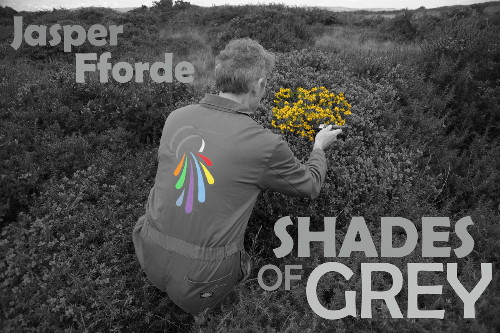|
|
|
|
|
|
|
|
|
|
|||
|
|
|
|
|
|
|
||||||
|
|
|
|
|
|
|
|
|
|
|
|
|
  An unused publicity snap of me painting in some gorse. Yes, the boilersuit really has been embroidered with the National Colour logo. |
This was a piece written for John Scalzi's excellent WHATEVER website. You can read his review with this piece HERE and some other 'Big Idea' archive just about HERE My Big Idea was not to use the Big Idea. Chuck it out, stuff it in the corner and relegate the obvious thread to the ignominy of subplot status. Then have the Small Idea advanced undeservedly to prominence. So my post-apocalyptic book has the nature of the 'Something that Happened' not only unanswered, but largely ignored. The remnants of the advanced technology that litter the landscape remain tantalisingly unexplored. All that remains of the Previous - mostly teeth, by now, complete with fillings - are simply trod underfoot. Anarchy is an alien concept; the world is ordered, neat, and static. The questions that dominate my character's lives range from how they can marry into the Oxblood family's String empire, the need to conduct a chair census, the visit to the Last Rabbit, the vexing question of where all the spoons went and, most important of all, how one can avoid the cold spectre of social embarrassment in a world obsessed with politeness and order? I like challenges. Write oneself into something of a pit and then miraculously break free. But this isn't some form of narrative suicide, it's another way of approaching Story. Here's why: I have twelve or so 'Writing Rules' and sandwiched between number Seven: 'Never use the word Majestic' and number Nine: 'On the hoof flexibility' I have: 'Always favour the less well trodden path'. An obvious adage, perhaps, but given the lamentable sameness of many novels, one that should be lifted to greater prominence. The theory is simple. You are walking in a metaphorical forest, chewing your metaphorical pencil and making narrative decisions, when you are presented with two paths - a well-worn route to safe, broadly-lit upland literary pastures, and a less-used one - a route towards experimentation, speculation, and risk. So I chose my idea - Post Apocalyptic Dystopia - and then noted the well trodden path: The immediate aftermath of a global upheaval. The population in disarray, citizens fighting for survival in a new world order. Too obvious. How about seven hundred years afterwards, when the fall of mankind has no more relevance than the Dark Ages has to us today? I don't know about you, but I rarely talk about Edward III's scandalous claim to the French throne in 1337, but it's all people talked about then. So we're seven hundred years on and - several less well trodden paths later - we're not talking about survival but simply getting through the day. A day in a different yet recognisable society based on different values and rules - visual colour in this case, where everything from social mobility, aspiration, health and commerce are based around colour. Earn enough and you can afford colorised bananas for dinner. More expensive, but it impresses the neighbours. The strict social hierarchy is decided not on something so hideously old fashioned as choice, intellect or the ability to lie convincingly to electors, but simply the colour you can see. If you are born able to see Purple you're at the top of the stack; If you are born without any colour vision at all, then you're at the bottom. Unquestionably objective. These are the sort of less well trodden paths I like. Because once you're seven or ten less-well trodden paths from that first, the path has become so faint that you might not actually be on a path at all. And if you are now walking through that virgin forest of originality, then you have strayed well. But it's not enough to think up a new idea. It has to work. And that's another less well trodden path all on its own. Landscape is one thing, characterisation and plotting quite another. And this is what I enjoy about the sort of writing I'm attempting in Shades of Grey - to try and give the mundane a narrative force all of its own. Two guys in a room and one of them has a gun? To me, that's just plain lazy. Two guys in a room and one of them has lied about whether he has seen the last rabbit or not? And this one lie is enough to have someone ostracised by society and a need to prove themselves as redemption? Now that's drama, and what's more, it's unconventional drama. The reader is always looking for something new and fresh and interesting, and since all the stories have pretty much been written, the bold frontier for authors these days is to further the technique of how they can be told - with different settings, different characters, different times - and for me, different values. In case you're wondering, we DO find out where all the spoons went, and you can learn how a tree goes Purple, and why the Green Room is better than the Mildew. You may even learn why nobody comes back from High Saffron, why there is a Caravaggio in the Greyzone and what Jane put in the Prefect's scones. It's narrative drive, but not as we usually know it. For me, the best Big Idea is the sneaky Small Idea that overtakes you on the inside when you're not watching. Jasper Fforde December 2009 |